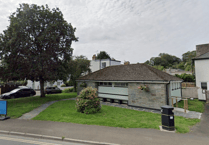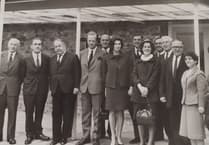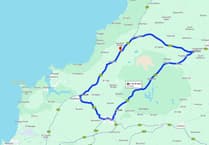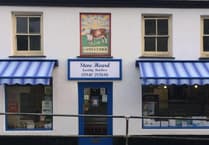A?NUMBER of residents made a passionate plea to Camelford Town Council to object to plans to build 104 homes on land at Valley Truckle.
The council meeting was moved to the larger room of Camelford Hall, in anticipation of a large turn-out, after the application came up for discussion on the agenda.
The application, for Mr I Roach, Wainhomes (SW) Holdings Ltd, seeks permission for the construction of 104 residential dwellings, associated highway and landscaping works and provision of an area of open space.
Comments made by residents at and following a recent policy consultation event, organised by Wainhomes, showed the level of feeling against the plans. Many commented about the loss of green space, highways issues and concern about the effect on the current infrastructure.
These issues were echoed at the town council meeting, during the public participation section, which was extended by the mayor in order that everyone present could have their say.
Kicking off the comments was Angela McGorrey who said: “The proposed development is literally on my doorstep.”
She told the meeting a notice had been pinned to the field where donkeys are currently kept, but she added: “How many people would have seen this notice? It also gives you the number for you to object to the planning officer and the number that you can get into to put your objections. How many people will have actually seen this?”
She was concerned that the people who went to the exhibition, and filled out forms while there, will have thought they were putting in their official objection, but they weren’t.
Stephen Bond said: “The town doesn’t have the infrastructure to support any more houses. Nobody can get a doctors appointment, you’ve got to know three weeks in advance if you’re ill. We don’t have a dentist, we don’t have any public transport links. I don’t feel we have the infrastructure to support any more properties.”
One lady asked the council: “Do you have a point at which you decide that we have enough development going on? Does it have to be Camelford?
“I was born here. I grew up here. I went to school here and I work here. I know what Camelford used to be like. There’s nothing here now. Why would anybody come and choose to live in Camelford? What do we need all these new houses for when there’s nothing for all the people in Camelford?
“The developments on the primary school site, there’s still some that are empty. Now we‘re saying let’s build more. I can’t work out why we need to have all this stuff here.”
Cllr Rotchell said there was a government number allocated to each network area, and that area has to build a certain number of houses. The Camelford network area’s allocation is short of 283 houses between now and 2030.
The lady asked what about the other villages in the network area, such as Tintagel, Boscastle, St Breward, Delabole and St Teath, but Cllr Rotchell said they have got a percentage as well.
Another lady replied: “If by 2030 we need to have built, then in 2017 we could spend more money on the infrastructure to make it a better place to live.”
Resident, Huw Huntley said: “I can’t understand why these houses are coming. The schools are filled up, we haven’t even got a proper ambulance service. There’s no banks. Camelford is dying, it needs resuscitating. Building these houses is not resuscitating it. Something needs to be done. As a town council, are you supporting this scheme? Looking at Camelford, it’s dead as far as I’m concerned.”
Another lady agreed, and recalled that many years ago there were signs around the town, about the regeneration of Camelford.
She added: “There’s no regeneration. Camelford is a dying town. I’ve driven through Camelford for 30 years. It just gets worse. Shops are closed, the ones open don’t sell anything people want to buy. Nobody wants to live in Camelford. It’s no good just building more and more houses. It ought to be addressed at some level.
“The thing that terrifies me is that they’re going to take at least three years to build these. The only means of access to the site is going to be the old B3266. The people who live there are not going to be able to access that road like they do today.”
She raised concern about the emergency services gaining access, and also for people with young children. She also noted that the air ambulance lands in the field where the donkeys are usually a couple of times a year.
“I think it should be completely done away with. It’s completely impractical to build them there. The ground around here is clay and it’s on rock. There’s very little top soil and drainage is appalling at best. If you cover it with more concrete you’re going to have nowhere for it to go. To me it’s madness, this entire scheme. It’s really time people said stop. Somewhere someone’s got to.”
One gentleman said the capacity of the schools worries him. Although he believed the developers would have to provide some money towards education, he said this would go on taxi fares to take children to outlying schools.
“I don’t think locals should have to fight for their children to go to Camelford schools.”
Problems with sewerage were also raised, with one resident saying: “In the height of the summer, we are taking out of Camelford something like 56,000 litres of treated sewage. This will increase. That’s going to put an even bigger burden on the town.”
One resident of Valley Truckle said traffic congestion would be worsened by more houses.
“There’s so much traffic in the summer, it builds up at the Bodmin junction in one direction and Collans Cross in the other. We are not going to be able to get out if all the traffic is backed up. If there’s an emergency, we are not going to be able to get out.“
She also spoke about the environmental impact of the houses, and called the donkey field ‘special’, a meadow that has been untainted for years.
“It’s a real natural habitat. It’s an asset to Valley Truckle. We really don’t want to lose it.”
The application for a dark sky validation on Bodmin Moor was also discussed, as Valley Truckle is in the buffer zone of this area. Residents felt that an extra 104 houses would have a negative impact on this.
“When you weigh it all up, where is the need for all these houses? It’s not going to draw people in. We will have ruined a pristine field. We will have made the life of people living in Camelford a nightmare with that traffic.”
Resident Jane Smith noted that a campsite, a holiday park and a Caravan Club site backs onto the site. “We want our Camelford back. The sign says Camelford welcomes walkers, but building more housing estates is not providing for tourists. It just does not make any sense at all.”
Another lady wrapped up the public comments by urging the council to look at the application wording.
“The clue is in the title —phase one. If we let them in with phase one, they will follow with phase two and three.”
The council moved into the main part of the meeting, with the Farriers Green application up first.
Cllr Andy Shaw detailed the points the council wished to make in their response, including the development being contrary to the national housing policy and the Cornwall Local Plan; affordable housing issues; overdevelopment for a rural town, noting the size of the bedrooms with some rooms only fit for a small child. In addition, the area is not highlighted in the plan for housing but for light industrial use.
Cllr Shaw added that full environmental checks had not taken place, and the council recommended a full 12-month survey be carried out.
Another point related to transport. Access would be onto the B3266, with tailbacks onto the A39, causing safety issues. The B3266 is an existing holiday diversion route, and possible HGV relief road as part of the air quality management area.
Cllr Shaw noted that a traffic survey was carried out in January, but this would not have provided accurate results.
A recommended lay-out would include a wider junction and a new roundabout or traffic lights onto the A39.
With regards to sewerage, Cllr Shaw said the existing system struggles to cope, with lorries taking waste away on a regular basis. This development would only exacerbate this.
“With representations I’ve received from residents from all areas of town, I can’t recommend supporting this application but would strongly object on the above grounds.”
Cllr Shaw proposed that the town council object most strongly to the application. This was seconded and all councillors voted in favour.
The final decision on the application is expected to be made by the plans committee of Cornwall Council.



